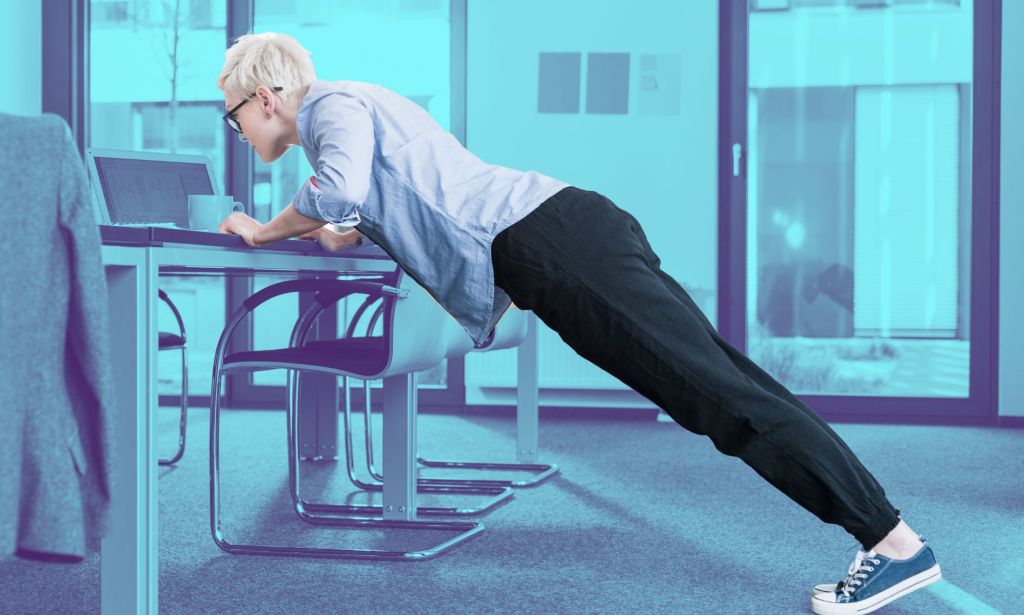7 ways to improve your mental health at work by staying active

The theme for this year’s Mental Health Awareness Week focuses on how physical activity can positively impact mental health. (Getty Images/PinkNews)
The theme of this year’s Mental Health Awareness Week stresses how physical movement can have a positive impact on one’s mental health.
According to the charity Mind, one in four people in the UK will experience a mental health problem each year. The most common mental health issues that people encounter are General Anxiety Disorder, depression, and post-traumatic stress disorder (PTSD).
For the LGBTQ+ community in particular, the data paints a bleaker picture, with research from Stonewall revealing that over half of LGBTQ+ people have experienced depression, and three in five have dealt with anxiety. One in eight LGBTQ+ young people aged 18 to 24 attempted to take their own life, and nearly half of all trans people have contemplated suicide.
While the overwhelmed and under-staffed NHS has seen mental health referrals soar to five million, up 33 per cent from 2019, and the high costs of private mental health care, it’s safe to assume that many dealing with mental health issues are forced to confront their struggles on their own.
Physical activity can improve mental health
One way to improve mental health and well-being is through physical activity. According to the Mental Health Foundation, as little as 15 minutes of physical activity can positively impact mental health. Further research showed that regular physical activity can reduce the risk of depression by 30 per cent, yet over one-third of people in the UK don’t meet the recommended guidelines for physical activity.
In the hustle and bustle of daily life, it’s easy to let physical activity fall by the wayside, especially during the workday. Physical activity doesn’t have to be intense gym sessions or running marathons, little routines can be incorporated into the workday to promote physical activity.
Here are a handful of simple yet effective ways to stay active during your workday, promoting not only physical health but also enhancing your mental well-being.
Opt for active commuting

If feasible, consider incorporating active transportation into your daily commute. Whether it’s walking, biking, or even skating to work, choosing an active mode of transportation adds physical activity to your day but also helps reduce stress levels by allowing you to connect with your surroundings and enjoy some fresh air before diving into your work.
Regular stretch breaks
Incorporating short stretch breaks throughout your workday can do wonders for your physical and mental well-being. Set a timer to remind yourself to stand up, stretch your arms, legs, and back, and take a few deep breaths.
These brief moments of movement can alleviate muscle tension, improve circulation, and provide a mental reset, enhancing focus and productivity.
Exercise at your desk

Who says you need to get to the gym to exercise? Simple exercises like chair squats, desk push-ups, or seated leg lifts can be seamlessly integrated into your work breaks, providing a quick burst of activity without disrupting your workflow.
These exercises promote physical health by targeting key muscle groups, but they also help combat sedentary behaviour, keeping your energy levels up throughout the day.
Walk and talks
Instead of confining your meetings to the meeting rooms or Zoom calls, opt for the occasional walking meetings. Whether it’s a one-on-one discussion or a brainstorming session with colleagues, take the conversation outdoors and enjoy a brisk walk while you exchange ideas.
Not only does walking stimulate creativity and problem-solving, but it also promotes camaraderie among team members, fostering a positive work environment.
Stand up once in a while

If you’re job confines you to a desk, combat the detrimental effects of prolonged sitting by incorporating standing intervals into your work routine. Invest in (or ask your employer) for a standing desk or use a makeshift setup to alternate between sitting and standing throughout the day.
Standing engages your muscles and improves posture but also boosts circulation and prevents the sluggishness often associated with prolonged sitting, helping you stay alert and focused on your tasks.
Lunchtime workouts
Make the most of your lunch break by squeezing in a quick workout session. Whether it’s a brisk walk around the block, a yoga session in a nearby park, or a HIIT workout in your living room, dedicating even just 30 minutes to physical activity during your lunch break can revitalize your body and mind, setting the stage for a productive afternoon.
Mindful movement
Embrace mindfulness practices that incorporate movement into your workday, such as tai chi, qigong, or novice yoga poses. These mind-body exercises not only promote physical flexibility and strength but also cultivate mental clarity and emotional resilience, helping you navigate the stress of daily life with greater ease.
If you’re struggling with your mental health and need to talk, contact Samaritans on 116 123 or Switchboard LGBT on 0300 330 0630.







